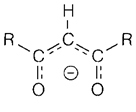Oxidation state +3
The Ln3+ state is the most stable under usual circumstances for all elements in the series. oxides Ln2O3 and Halides LnX3 are known for all elements, with an extensive variety of oxo salts that are including mixed and hydrated compounds like Ln2(SO4)3.3Na2(SO4).12H2O. Ionic radii change from 104 pm (La3+) to 86 pm (Lu3+) and this comparatively large size for 3+ ions (cf. Al3+ 53 pm) is related with respectively high coordination numbers in solid compounds. LnF3 compounds for previous elements have nine-coordination, Ln2O3 are seven-coordinate. For the afterwards Ln elements the decrease in radius leads to alteration in structure with reduction in coordination.
The aqua Ln3+ ions depict little acidity that increases from La to Lu as the radius decreases but is still very much less than for Al3+. Strong complexes are created along with hard oxygen donor ligands, and particularly chelating ones like EDTA or β-diketonates (L-L=[RC(O)CHC(O)R]- 1), that provide eight-coordinate complexes [Ln(L-L)4]-. Complex strengths usually increase across the series like the radius decreases, and this might be employed to separate a mixture of Ln3+ ions. For instance, in an ion-exchange chromatography column along with a complexing

agent exist in aqueous solution, the earlier lanthanides, that are less strongly complexed, are reserved preferentially on the elute and column very slowly.
The organometallic chemistry of lanthanides is very much limited than within the d block. Compounds like (C5H5)3Ln and (C5H5)2LnX (X=Cl, H, etc.) contain more ionic character than for transition elements and compounds along with neutral ligands like CO are not stable. Though a few interesting chemistry has, been found with compounds like (C5(CH3)5)2LuH where a bulky ligand is combine with a small lanthanide. For instance, the methane activation reaction takes place under mild circumstances in solution.